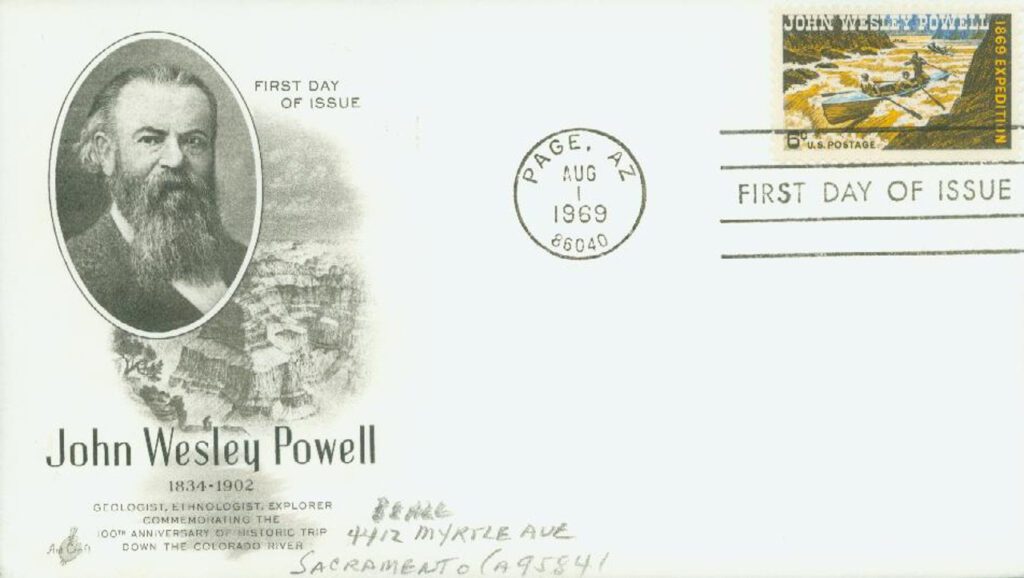Soldier, geologist, and explorer John Wesley Powell was born on March 24, 1834, in Mount Morris, New York. A Civil War veteran, Powell explored and produced some of the first accurate maps of the West and later was director of the US Geological Survey.
When he was a child, Powell’s family moved to Ohio before settling in Illinois. In his teens and early 20s Powell explored the Mississippi River Valley and walked across Wisconsin for four months. Powell attended college for several years, while also teaching, but didn’t earn his degree. By 1860, he realized that America was destined for war and began studying military science and engineering.
Powell supported the Union and opposed slavery, so he joined the Union Army in the 20th Illinois Infantry. He was elected sergeant major of his regiment and was promoted to second lieutenant. During the war, he served as a mapmaker and military engineer.
While stationed in Missouri, Powell formed an artillery company and became captain. In the Battle of Shiloh, he was hit by enemy fire and lost his right arm. In spite of his injury, Powell returned to the army and participated in the siege of Vicksburg and the Atlanta Campaign. He always had an interest in geology and was known to study rocks in the trenches.
After the war, Powell became a professor of geology at a university in Illinois. He helped the institution expand their natural history museum. They offered him a permanent position, but he was anxious to explore the American West.
By 1868, Powell had studied countless reports and spoke with Native Americans, hunters, and mountain men. He was convinced that exploring the Colorado River on small boats would be possible. He petitioned the War Department and the Smithsonian Institution for assistance and they provided him with scientific instruments to collect samples and further study the area. In time, Powell acquired four boats and gathered enough supplies and food to last him and his crew of nine for six to nine months.
On May 24, 1869, Powell and his men began their journey in Wyoming’s Green River, while locals stood on the shore shouting and cheering, encouraging them though they expected to never see the men again. While making their way downstream, Powell accurately suggested that the river had existed long before the canyons and that it had cut through the rock as the plateau rose.
Along their journey, Powell and his party named many sites in the Grand Canyon, including Flaming Gorge, Canyon of Lodore, Whirlpool Canyon, Split Mountain, Dirty Devil Stream, Bright Angel Stream, Gray Canyon, and Marble Canyon. Three months into the expedition, the party reached their destination – the Virgin River. They had traveled 1,000 miles through uncharted canyons and Powell returned home a national hero.
Upon his return home to Illinois, Powell immediately began lecturing to raise money for a second trip. His first trip had been so successful, he had little trouble getting money from Congress. His 1871-72 expedition through the Grand Canyon was even more successful – producing the first accurate maps of the area, and over 100 photographs.
Powell went on to become director of the US Geological Survey as well as the Bureau of Ethnology at the Smithsonian. He also published a book about his expeditions. Based on his trips, Powell submitted a report on the West, suggesting state boundaries and irrigation systems based on watershed areas, to prevent disagreements among the states. He also had suggestions for conservation that railroad companies didn’t agree with. In the end Congress supported the agricultural use of the land based on the flawed belief that “rain follows the plow,” or that agricultural use increased the humidity of a region. However, Powell was correct and his fears would later prove true in the Dust Bowl of the 1920s and 30s.
Powell died on September 23, 1902, at his summer home in Brooklin, Maine. As a Civil war veteran, he was buried in Arlington Cemetery.
Click here for photos from Powell’s expeditions.
| FREE printable This Day in History album pages Download a PDF of today’s article. Get a binder or other supplies to create your This Day in History album. |
Discover what else happened on This Day in History.







What a life WesleyPowell had! Your brief history of Powell explains why the huge Lake Powell in the southwest is named after him.
I don’t know what Powel would think of the lake that was named after him, but Glen Canyon Dam that that blocked the flow of the Colorado River and formed Lake Powell is one of the worst environmental and ecological disasters that the U.S. ever undertook. Because of the silt that flows down the river and is deposited at the bottom, the lake has lost about 9-10% of its storage capacity. Because of the mega-drought that has gripped the west in the last quarter of a century, Lake Powell is at the lowest level since the dam was completed in the 1960s. The dam was built primarily for power generation and water storage, but the lake will probably never be full again.